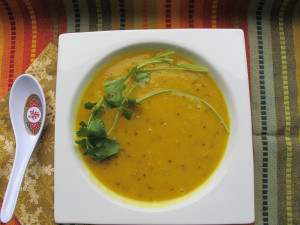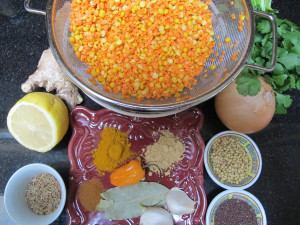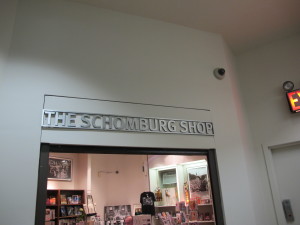

February foods hold many passions for me. Blessed with diverse cooking genes, I’m always torn between Creole foods served during Trinidad Carnival and Louisiana Mardi Gras, and/or Chinese New Year’s food. In the end, my mother’s Chinese Trinidadian Dahl won out. With New York’s frigid weather and a recent cold, this steaming hot, flavorful vegan pea soup hit the spot. Dahl, Daal, or Dal are common spellings for this aromatic soup.
Dahl is simple, easy and a great introduction to Indian cooking. All you need are some split peas, vegetable broth and Indian spices. This recipe is on the thick side because Trinis usually serve it with rice. You may add broth at the end to make it soupier. Use Chana Dal peas, when cooking for Diabetics (for better glycemic index). They look like yellow split peas and are found only in Indian grocers. My sister adds more vegetables and also uses coconut milk, a tradition for many. There are many ways to prepare Dahl. This recipe is a good starter. Let me know how it goes.
For a great introduction to Trinidad’s diverse culinary scene in New York check: “Roti, Shark, and Buss-up Shot-Get to know the Trinidadian food of NYC,” click here.
For one of my Mardi Gras recipes, check out a guest post on friend Patricia Patton’s site that featured my Vegan Creole Gumbo Recipe. Click here for details.
I will write about Chinese New Years in a future post. But to read my past holiday post, click here.
Trinidad Dahl Soup Recipe
Equipment: 5 qt. soup pot, medium fry pan, large bowl to wash peas, colander to rinse peas; optional potato masher or immersion blender. Total prep & cooking time: 1 hour 30 minutes or less. Serves 6.
Ingredients:
1 T vegetable oil
1 chopped medium onion
4 garlic cloves, smashed or split
6 cups vegetable broth
2 cups split peas=1 cup yellow, 1 cup red
1 Bay Leaf
1 Scotch Bonnet Pepper or Habanero
1 T Tumeric
1 tsp. Ginger powder
1 tsp. Cayenne
2 tsp. Ginger chopped
1 T Brown Mustard seeds
1 T Cumin seeds
1 T Coriander Seeds
1 tsp. Sea Salt, to taste
Garnish: 1 cup Cilantro, chopped and sprigs, 1 Lemon.
Prep & Cook: Wash peas in cold water, drain in colander, chop onions, smash garlic, mince ginger, measure out all seasonings and put all aside.
Add peas to pot, add 5 cups of broth (reserve 1 cup for adding at end), 2 whole, smashed garlic cloves, 1 Bay Leaf, 1 whole Scotch Bonnet or Habanero Pepper, Tumeric. You should have at least 2 inches of liquid above peas. Bring to boil. Lower the flame to a medium heat, cook about 40 minutes, or until peas are tender. Almost finished!
To set up the soup for the finish, remove and discard Bay Leaf. Remove and put aside Scotch Bonnet or Habanero pepper. Use masher or immersion blender to puree it to your preferred creamy consistency. I usually skip that part or use a hand masher. Maintain a very low heat.
In fry pan, cook the rest of the ingredients in oil: chopped onion, remainder 2 garlic cloves, ginger powder, chopped ginger pieces, Cayenne, until onions are translucent. Add all the whole seeds as last items-Mustard, Cumin, and Coriander. Mix seeds into onion-garlic mixture just for a few seconds. Scrape contents of fry pan into soup and stir. Add pepper back to pot. Add salt and additional broth and water, to desired consistency. Heat to bubble, turn very low for about 10 minutes. Stir, and taste. Done!
Serve and garnish each bowl with Cilantro and a squeeze of Lemon. Eat with rice or Nan bread. Enjoy!

